


Video and Audio
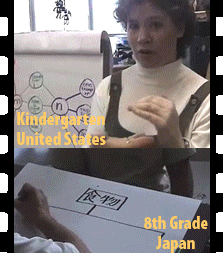 The video clips on the Thinking Foundation website include selections from pre K through 12 and college. The video clips include seeing students, educators and administrators from across the USA and around the world including Mexico, Japan, and Britain. Scroll down to read about and select video clips.
The video clips on the Thinking Foundation website include selections from pre K through 12 and college. The video clips include seeing students, educators and administrators from across the USA and around the world including Mexico, Japan, and Britain. Scroll down to read about and select video clips.
The video clips on the Thinking Foundation website are in Quicktime and Windows Media Player. If you are unable to watch any of the video clips in your browser, download the plug-ins in Quicktime or Windows Media Player. Quicktime (Macintosh and Windows) is recommended for the best quality viewing experience.
Download the Quicktime plug-in (Macintosh and Windows)
Download the Windows Media Player plug-in (Windows)
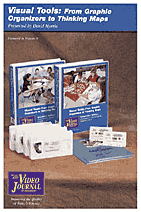 Video Series about Thinking Maps®: Visual Tools: From Graphic Organizers to Thinking Maps® presented by David Hyerle
Video Series about Thinking Maps®: Visual Tools: From Graphic Organizers to Thinking Maps® presented by David Hyerle
The Video Journal of Education (TeachStream) went all over the country to document and discover the power of visual tools and Thinking Maps®. The Elementary and Secondary Editions of this video series provides extensive classroom examples from kindergarten to junior college and from California to North Carolina. Learn more about the TeachStream Thinking Maps® Video Series including ordering the series at Designs for Thinking.
The following video clip includes excerpts from the Video Series about Thinking Maps.
![]() Watch the video clip in Quicktime (8:38)
Watch the video clip in Quicktime (8:38)
![]() Watch the video clip in Windows Media Player (8:38)
Watch the video clip in Windows Media Player (8:38)
Constructivist Thinking in Mexico
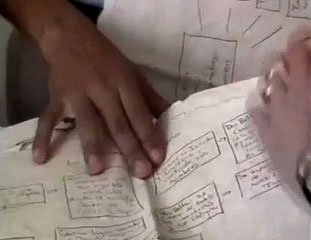 Visit a school in Mérida, Yucatán, Mexico that deeply
Visit a school in Mérida, Yucatán, Mexico that deeply
understands the use of Thinking Maps. Watch and listen
to a fabulous interview with the school's principal followed
by an insightful teacher sharing many student examples
of their visual thinking.
“Part of our model was teaching the students to learn for themselves and by themselves.”
“We needed something for them to visualize the processes that help them think.”
“One of the most difficult things in education is thinking about what the student needs to be thinking.”
The video clip starts with the principal interview, then is followed by the student examples.
![]() Watch the Mexico video clip in Quicktime (8:38)
Watch the Mexico video clip in Quicktime (8:38)
![]() Watch the Mexico video clip in Windows Media Player (8:38)
Watch the Mexico video clip in Windows Media Player (8:38)
Thinking in Great Britain
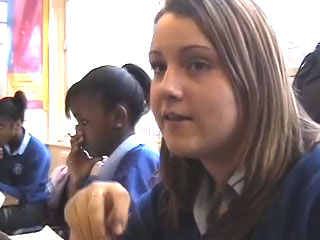 Visit a high school classroom in Great Britain including an interview with the Geography Teacher and two students. The teacher shares insights on thinking skills to “...put the notes into a form more conceptually understandable...”. The interview with the teacher is structured into purpose of use; comcept development; and their understanding. The two student interviews include reflections on tools of thinking including the observations of:
Visit a high school classroom in Great Britain including an interview with the Geography Teacher and two students. The teacher shares insights on thinking skills to “...put the notes into a form more conceptually understandable...”. The interview with the teacher is structured into purpose of use; comcept development; and their understanding. The two student interviews include reflections on tools of thinking including the observations of:
“That is brilliant”
“I'm able to think easier... makes things clearer in the mind...”
“...get more between the lines...”
The video clip with the two students.
![]() Watch the Great Britain student video clip in Quicktime (3:15)
Watch the Great Britain student video clip in Quicktime (3:15)
![]() Watch the Great Britain student video clip in Windows Media Player (3:15)
Watch the Great Britain student video clip in Windows Media Player (3:15)
The video clip with the Geography Teacher.
![]() Watch the Great Britain teacher video clip in Quicktime (3:10)
Watch the Great Britain teacher video clip in Quicktime (3:10)
![]() Watch the Great Britain teacher video clip in Windows Media Player (3:10)
Watch the Great Britain teacher video clip in Windows Media Player (3:10)
Differentiation in a Multilingual School
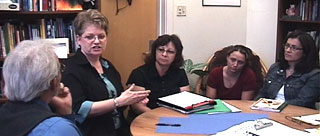 Stefanie Holzman, principal of Roosevelt Elementary School in Long Beach, California, is interviewed in a classroom about differentiation by David Hyerle. Roosevelt Elementary School is an urban, inner city, K–5 school of 1200 minority students (85% of those entering with Spanish as their primary language) that continues to have extraordinary success with teacher and student thinking skills including consistent growth on the state API test scores well beyond the state expectations. The video clip Differentiation in a Multilingual School.
Stefanie Holzman, principal of Roosevelt Elementary School in Long Beach, California, is interviewed in a classroom about differentiation by David Hyerle. Roosevelt Elementary School is an urban, inner city, K–5 school of 1200 minority students (85% of those entering with Spanish as their primary language) that continues to have extraordinary success with teacher and student thinking skills including consistent growth on the state API test scores well beyond the state expectations. The video clip Differentiation in a Multilingual School.
![]() Watch the Differentiation in a Multilingual School in Quicktime (2:23)
Watch the Differentiation in a Multilingual School in Quicktime (2:23)
![]() Watch the Differentiation in a Multilingual School in Windows Media Player (2:23)
Watch the Differentiation in a Multilingual School in Windows Media Player (2:23)
Listen to the Leadership Team at Roosevelt Elementary School discuss their success with Thinking Maps as a staff and with the students. More information about Roosevelt Elementary School is part of the book Student Successes With Thinking Maps — read excerpts from the chapter and other information about the student successes. The video clip Roosevelt Elementary School Leadership Team.
![]() Watch the Roosevelt Leadership Team in Quicktime (2:23)
Watch the Roosevelt Leadership Team in Quicktime (2:23)
![]() Watch the Roosevelt Leadership Team in Windows Media Player (2:23)
Watch the Roosevelt Leadership Team in Windows Media Player (2:23)
Organize Our Thinking in a Japanese Classroom
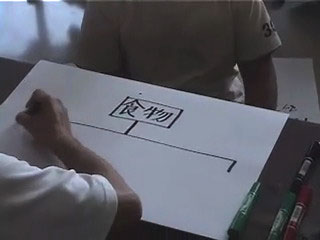 Thinking Maps are introduced to an eighth grade class at Higashi-Monzen Elementary School in Kawasaki City, Kanagawa Prefecture, Japan. The students learn each of the eight maps from Robert Price and their teacher Shunji Muroga with the assistance of a translator. After the students learn the eight maps, they then organize their thinking about a historical figure using the Thinking Map to best express their different ways of thinking.
Thinking Maps are introduced to an eighth grade class at Higashi-Monzen Elementary School in Kawasaki City, Kanagawa Prefecture, Japan. The students learn each of the eight maps from Robert Price and their teacher Shunji Muroga with the assistance of a translator. After the students learn the eight maps, they then organize their thinking about a historical figure using the Thinking Map to best express their different ways of thinking.
The video clip takes place in Higashi-Monzen Elementary School.
![]() Watch the Organize Our Thinking in Japan video clip in Quicktime (8:53)
Watch the Organize Our Thinking in Japan video clip in Quicktime (8:53)
![]() Watch the Organize Our Thinking in Japan video clip in Media Player (8:53)
Watch the Organize Our Thinking in Japan video clip in Media Player (8:53)
Visual Thinking in Pre-K
 A Pre-K teacher at Bellevue Heights Nursery School in Syracuse, NY shares her students success with visual mapping as a group and their own work with mapping their ideas. She shares her insights, learning, and examples of the students thinking. A very dynamic teacher sharing some very exciting dynamics of the classroom.
A Pre-K teacher at Bellevue Heights Nursery School in Syracuse, NY shares her students success with visual mapping as a group and their own work with mapping their ideas. She shares her insights, learning, and examples of the students thinking. A very dynamic teacher sharing some very exciting dynamics of the classroom.
![]() Watch the Visual Thinking in Pre-K video clip in Quicktime (7:11)
Watch the Visual Thinking in Pre-K video clip in Quicktime (7:11)
![]() Watch the Visual Thinking in Pre-K video clip in Windows Media Player (7:11)
Watch the Visual Thinking in Pre-K video clip in Windows Media Player (7:11)
Thinking Maps® International Conference Leadership Panel
 Thinking Maps are a language for transforming leadership. Hear a panel of educational leaders discuss their implementation, successes, and visions on using Thinking Maps® as a language for leadership in their respective districts. The video clip takes place at the Thinking Maps® International Conference held in Texas during July 2007.
Thinking Maps are a language for transforming leadership. Hear a panel of educational leaders discuss their implementation, successes, and visions on using Thinking Maps® as a language for leadership in their respective districts. The video clip takes place at the Thinking Maps® International Conference held in Texas during July 2007.
![]() Watch the Thinking Maps Leadership Panel video clip in Quicktime (8:53)
Watch the Thinking Maps Leadership Panel video clip in Quicktime (8:53)
![]() Watch the Thinking Maps Leadership Panel video clip in Media Player (8:53)
Watch the Thinking Maps Leadership Panel video clip in Media Player (8:53)
Organize Our Thinking in a First Grade Classroom
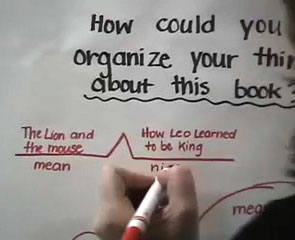 Watch a first grade classroom organize their thinking using different Thinking Maps to share insights into the book Leo the Lion, then use the Thinking Map that best suits their thinking and learning styles individually. More information about Mt. Airy Elementary School is part of the book Student Successes With Thinking Maps — read excerpts from the chapter and other information about the student successes.
Watch a first grade classroom organize their thinking using different Thinking Maps to share insights into the book Leo the Lion, then use the Thinking Map that best suits their thinking and learning styles individually. More information about Mt. Airy Elementary School is part of the book Student Successes With Thinking Maps — read excerpts from the chapter and other information about the student successes.
The video clip includes students sharing ideas whole class and working individually.
![]() Watch the Organize Our Thinking video clip in Quicktime (7:42)
Watch the Organize Our Thinking video clip in Quicktime (7:42)
![]() Watch the Organize Our Thinking video clip in Windows Media Player (7:42)
Watch the Organize Our Thinking video clip in Windows Media Player (7:42)
The Road to Reading Comprehension - an Interview with Principal Thomasina DePinto Piercy, Ph.D. - Mt. Airy Elementary
 An interview by David Hyerle, Ed.D. with the principal of Mt. Airy Elementary School Thomasina DePinto Piercy, Ph.D. The interview includes sections on: Using Thinking Maps; Thinking Maps with Leadership; Making Connections with Thinking Maps; Growth with Students; and Comprehension. More information about Mt. Airy Elementary School is part of the book Student Successes With Thinking Maps — read excerpts from the chapter and other information about the student successes.
An interview by David Hyerle, Ed.D. with the principal of Mt. Airy Elementary School Thomasina DePinto Piercy, Ph.D. The interview includes sections on: Using Thinking Maps; Thinking Maps with Leadership; Making Connections with Thinking Maps; Growth with Students; and Comprehension. More information about Mt. Airy Elementary School is part of the book Student Successes With Thinking Maps — read excerpts from the chapter and other information about the student successes.
![]() Watch the Road to Reading Comprehension video clip in Quicktime (13:20)
Watch the Road to Reading Comprehension video clip in Quicktime (13:20)
![]() Watch the Road to Reading Comprehension video clip in Windows Media Player (13:20)
Watch the Road to Reading Comprehension video clip in Windows Media Player (13:20)
Collegial Coaching - Connecting Culture, Language, and Cognition
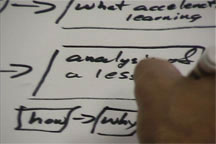 Robert Price, an education consultant, leading a Collegial Coaching session with Yvette Jackson, Excecutive Director of National Urban Alliance. The collegial coaching is just prior to Yvette Jackson leading a session with new National Urban Alliance consultants. Key elements include the purpose and goals of the session; the frame of reference of each of the new consultants; and the flow of the session. Read excerpts from Yvette Jackson's chapter Closing the Gap By Connecting Culture, Language, and Cognition in the book Student Successes With Thinking Maps.
Robert Price, an education consultant, leading a Collegial Coaching session with Yvette Jackson, Excecutive Director of National Urban Alliance. The collegial coaching is just prior to Yvette Jackson leading a session with new National Urban Alliance consultants. Key elements include the purpose and goals of the session; the frame of reference of each of the new consultants; and the flow of the session. Read excerpts from Yvette Jackson's chapter Closing the Gap By Connecting Culture, Language, and Cognition in the book Student Successes With Thinking Maps.
![]() Watch the Collegial Coaching video clip in Quicktime (6:45)
Watch the Collegial Coaching video clip in Quicktime (6:45)
![]() Watch the Collegial Coaching video clip in Windows Media Player (6:45)
Watch the Collegial Coaching video clip in Windows Media Player (6:45)
From Students to Leadership to School Board
 Marcie Roberts, principal at Norman Howard School in Rochester, NY shares insights and successes with using Thinking Maps systemically with students, leadership decision making, and the school board. Macie shares how the school board learns and wants a new tool for their use - the same tool the students are using to organize their thinking.
Marcie Roberts, principal at Norman Howard School in Rochester, NY shares insights and successes with using Thinking Maps systemically with students, leadership decision making, and the school board. Macie shares how the school board learns and wants a new tool for their use - the same tool the students are using to organize their thinking.
![]() Watch the From Students to Leadership to School Board video clip in Quicktime (7:11)
Watch the From Students to Leadership to School Board video clip in Quicktime (7:11)
![]() Watch the From Students to Leadership to School Board in Windows Media Player (7:11)
Watch the From Students to Leadership to School Board in Windows Media Player (7:11)
Visualizing Letter Discrimination
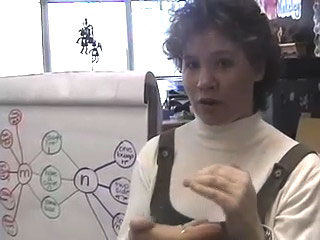 Lets step into a kindergarten classroom to see and hear how the classroom teacher uses visual tools to help her students understand their thinking — including visualizing character structure to develop and learn phonetic associations and understanding.
Lets step into a kindergarten classroom to see and hear how the classroom teacher uses visual tools to help her students understand their thinking — including visualizing character structure to develop and learn phonetic associations and understanding.
![]() Watch the Visualizing Phonics video clip in Quicktime (4:03)
Watch the Visualizing Phonics video clip in Quicktime (4:03)
![]() Watch the Visualizing Phonics in Windows Media Player (4:03)
Watch the Visualizing Phonics in Windows Media Player (4:03)
Organizing Thinking in College, and in Life
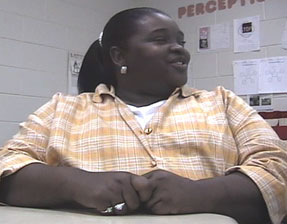 An interview with a college student at Jones County Junior College in Ellisville, Mississippi. Here this thoughtful student share how visual mapping transformed her return to college, and influenced her husband's business as well as her teaching children at her church.
An interview with a college student at Jones County Junior College in Ellisville, Mississippi. Here this thoughtful student share how visual mapping transformed her return to college, and influenced her husband's business as well as her teaching children at her church.
“I use Thinking Maps in every class that I have.”
“Not only does it help you academically, it does something for your whole personality.”
“Something that is so simple is so complex.”
![]() Watch the college student video clip in Quicktime (4:01)
Watch the college student video clip in Quicktime (4:01)
![]() Watch the college student video clip in Windows Media Player (4:01)
Watch the college student video clip in Windows Media Player (4:01)
Visualizing Thought Process Helps Students Transition to High School
 David Hyerle, Ed.D. completed graduate work at U.S.C. Berkeley and Harvard Graduate School of Education to investigate learning tools. As a Scholar in Residence at Plymouth State College, Dr. Hyerle consulted with Plymouth High School on the exhibit. The two video clips on the Apple Teaching Practice online professional development website are part of the online exhibit. David reflects on Thinking Maps® as a tool for transition, and speaks about Thinking Maps and self reflection. Go to the Apple Teaching Practice website to watch the video clips, as well as read and watch other parts of the exhibit.
David Hyerle, Ed.D. completed graduate work at U.S.C. Berkeley and Harvard Graduate School of Education to investigate learning tools. As a Scholar in Residence at Plymouth State College, Dr. Hyerle consulted with Plymouth High School on the exhibit. The two video clips on the Apple Teaching Practice online professional development website are part of the online exhibit. David reflects on Thinking Maps® as a tool for transition, and speaks about Thinking Maps and self reflection. Go to the Apple Teaching Practice website to watch the video clips, as well as read and watch other parts of the exhibit.
Learning as a Visual Process
New Hampshire Public Radio
June 20, 2002
![]() David Hyerle, Ed.D., is a guest on the New Hampshire Public Radio program The Front Porch hosted by John Walters. "David Hyerle is an educator with a radical
David Hyerle, Ed.D., is a guest on the New Hampshire Public Radio program The Front Porch hosted by John Walters. "David Hyerle is an educator with a radical  notion- teaching students HOW to learn. In his method, students aquire a "tool box" of what he calls "thinking maps." Thinking maps are learning techniques that help students organize information visually. He says his method helps people nor only retain what they are taught, but use it creatively."
notion- teaching students HOW to learn. In his method, students aquire a "tool box" of what he calls "thinking maps." Thinking maps are learning techniques that help students organize information visually. He says his method helps people nor only retain what they are taught, but use it creatively."
Listen to the NPR radio program The Front Porch interview with David Hyerle. (30:00)
Scroll up to read about and select video or audio clips, or select a video clip by the menu below.